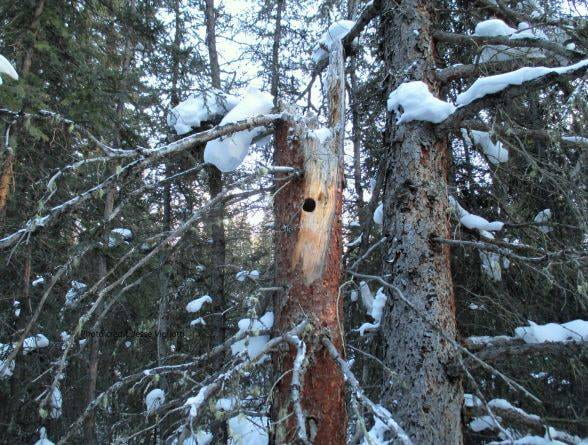This research was conducted by Jesse Vigliotti, a Master’s student at Yukon University/University of Alberta, 2017-2020. A copy of Jesse’s thesis is available as a pdf below.

Cavity using birds and mammals are significant components of boreal forest communities, and the availability of tree cavities suitable for roosting and resting may be critical for supporting these communities. Furthermore, cavity availability and habitat suitability may limit populations of over-wintering northern species that use tree cavities as a strategy for coping with extreme cold. Currently, no known research has investigated the potential cavity, tree or habitat requirements of over-wintering, northern boreal species. Therefore, the objectives of this study were 1) to examine winter cavity-use by birds and mammals in relation to cavity availability in southern Yukon, and 2) to examine the influence of cavity microclimate on winter cavity selection.
Four study areas were established throughout southern Yukon, each containing white spruce (Picea glauca), lodgepole pine (Pinus contorta), mixedwood (white spruce/trembling aspen (Populus tremuloides)), and spruce bark beetle (Dendroctonus rufipennis) affected spruce forest sites. Tree-cavities were located within each site and surveyed during the day and night to observe cavity use by birds and mammals. Cavity, tree and habitat characteristics were recorded for comparisons among forest types, between healthy and beetle-affected forests, and between used and unused cavities. Densities and proportions of natural and excavated cavities were not significantly different among forest types; however, some cavity characteristics differed among spruce, mixedwood and pine forests (i.e. cavity height, entrance shape and tree appearance), and between healthy and beetle-affected forests (i.e. cavity height, entrance area and tree appearance). Cavity volume, height and live conifer cover best predicted cavity-use for all bird species; however, only live conifer cover was a predictor of cavity-use for American three-toed woodpeckers (Picoides dorsalis). Three-toed woodpeckers preferred to roost in relatively healthy spruce forests, while boreal chickadees (Poecile hudsonicus), and hairy woodpeckers (Dryobates villosus) preferred to roost in pine forests. All species avoided beetle-affected spruce forests. Overall, birds preferred smaller, deeper, east-oriented cavities with relatively small entrances, located within forests with high live conifer cover. Lower, shallower cavities in small-diameter trees were avoided. Surprisingly, mammals were not observed resting in tree-cavities; however, red squirrels (Tamiasciurus hudsonicus) and northern flying squirrels (Glaucomys sabrinus) did use cavities for caching food and appeared to prey or scavenge on cavity-roosting birds.
The importance of cavity microclimate to roost-site selection was examined by determining which cavity, tree and habitat characteristics affected cavity temperatures, and by exploring the relationships between cavity-site temperatures and cavity use. Average sunset temperature increment (air temperature – cavity temperature), along with cavity height, depth, and volume, were predictors of cavity-use for three-toed woodpeckers; however average nightly temperature was not a predictor of cavity-use. Neither nightly nor sunset temperatures were predictors of cavity-use when all species were combined, which suggests that microclimate was a less important consideration in cavity selection by species other than three-toed woodpeckers. Though not a predictor of cavity-use, diameter-at-cavity-height had a significant positive effect on cavity temperatures. Entrance orientation had a significant negative effect on nightly cavity temperatures, with south-facing entrances having lower average nightly temperatures, likely due to wind effects. Smaller and deeper cavities were warmer and were preferred by roosting birds, and both variables were also predictors of cavity-use. Live conifer densities had a positive effect on external air temperatures but were not a predictor of cavity-use when temperatures were included in analyses.
Beetle-affected forests contained more potential roost-sites than did other forest types but were avoided by cavity-users. Though salvage-logging in beetle-affected forests may not affect resident cavity-roosting bird populations, more research is needed to fully understand the importance of these forests to cavity-using birds and mammals. Mature, structurally complex conifer forests were important winter-roost habitat for most cavity-users; therefore, these forests should be preserved to maintain the integrity of the cavity-using boreal forest community.
The results of this project were presented at the International Ornithological Congress in Vancouver, BC, in 2018.
Supervisory Committee:
Dr. Kathryn Aitken, School of Science, Yukon University and Adjunct Professor, Dept. of Renewable Resources, University of Alberta, Co-supervisor
Dr. Fiona Schmiegelow, Professor & Director, Northern Environmental and Conservation Sciences Program, Dept. of Renewable Resources, University of Alberta, and School of Science, Yukon University, Co-supervisor
Thomas Jung, Senior Wildlife Biologist, Yukon Government, Committee Member
Project Funders:
This research was supported by funding from Yukon University’s Scholarly Activity Grant program (formerly the Yukon College Research Fund), Polar Knowledge Canada’s Northern Scientific Training Program, University of Alberta Northern Research Award, W. Garfield Weston Foundation Award in Northern Research, and Yukon Fish and Wildlife Enhancement Trust Research Grant, as well as by in-kind support from Yukon Government and Environment and Climate Change Canada (Canadian Wildlife Service).